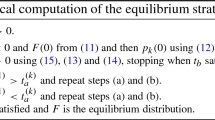Abstract
Considering that customer arrival is a peak and post-peak period, we establish a fluid model of queuing behavior. In order to reduce the sum of waiting time of customers, we study the method of the setting and optimization of quick queue in a random service system. Under the premise of the total number of service equipment, we construct two queuing models, with one including only common queues and the other including both common and quick queues and propose the formulas for calculating the sum of the waiting time of the two models. In the two cases of peak and post-peak periods, we analyze the effect of quick queue on service system performance. And we present the method for calculating the number of quick queues that gives the best overall system performance. Taking the quick queue setting and optimization of the supermarket service system as an example, we verify the validity of the proposed method, which indicates the reference value of the method to the management practice.



Similar content being viewed by others
References
Lees-Miller, J.D.: Minimising average passenger waiting time in personal rapid transit systems. Ann. Oper. Res. 236(2), 405–424 (2016)
Castaing, J., Cohn, A., Denton, B., et al.: A stochastic programming approach to reduce patient wait times and overtime in an outpatient infusion center. IIE Trans. Healthc. Syst. Eng. 6(3), 111–125 (2016)
Xu, Y., Schellerwolf, A., Sycara, K.: The benefit of introducing variability in single-server queues with application to quality-based service domains. Oper. Res. 63(1), 233–246 (2012)
Graves, S.C.: The application of queueing theory to continuous perishable inventory systems. Manage. Sci. 28(4), 400–406 (1982)
Rashid, R., Hoseini, S.F., Gholamian, M.R., et al.: Application of queuing theory in production-inventory optimization. J. Ind. Eng. Int. 11(4), 485–494 (2015)
Wang, H., Olsen, T.L., Liu, G.: Service capacity competition with peak arrivals and delay sensitive customers. Omega 77, 80–95 (2018)
Liu, Y., Whitt, W.: A network of time-varying many-server fluid queues with customer abandonment. Oper. Res. 59(4), 835–846 (2010)
Takagi, H.: Waiting time in the \(M/M/m\) LCFS nonpreemptive priority queue with impatient customers. Ann. Oper. Res. 247(1), 1–33 (2015)
Xie, Y., Liang, X., Ma, L., et al.: Inventory rationing and markdown strategy in the presence of lead-time sensitive customers. Oper. Res. Lett. 44(4), 525–531 (2016)
Hamadi, H.M.A., Sangeetha, N., Sivakumar, B.: Optimal control of service parameter for a perishable inventory system maintained at service facility with impatient customers. Ann. Oper. Res. 233(1), 3–23 (2015)
Anand, K.S., Pac, M.F., Veeraraghavan, S.: Quality-speed conundrum: trade-offs in customer-intensive services. Manage. Sci. 57(1), 40–56 (2011)
Alexander, K., Ali, M., John, C.P., et al.: An integrated model of patient and staff satisfaction using queuing theory. IEEE J. Transl. Eng. Health Med. 3, 1–10 (2015)
L’Ecuyer, P., Maill, P., Stiermoses, N.E., et al.: Revenue-maximizing rankings for online platforms with quality-sensitive consumers. Oper. Res. 65(2), 408–423 (2017)
Ni, G., Xu, Y., Dong, Y.: Price and speed decisions in customer-intensive services with two classes of customers. Eur. J. Oper. Res. 228(2), 427–436 (2013)
Acknowledgements
This work is supported by the National Natural Science Foundation of China under Grants 71521001, 71690235, 71471052, 71671055, and the Natural Science Foundation of Anhui Province of China under Grant 1708085MG169.
Author information
Authors and Affiliations
Corresponding author
Rights and permissions
About this article
Cite this article
Li, K., Pan, Y., Cheng, B. et al. The Setting and Optimization of Quick Queue. J Optim Theory Appl 178, 1014–1026 (2018). https://doi.org/10.1007/s10957-018-1333-2
Received:
Accepted:
Published:
Issue Date:
DOI: https://doi.org/10.1007/s10957-018-1333-2




